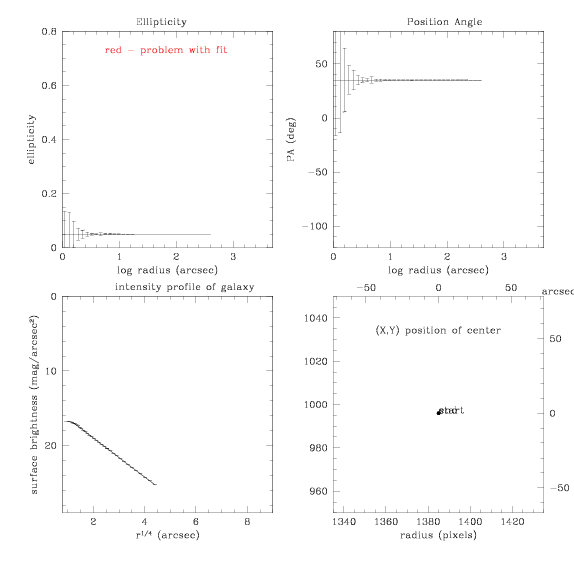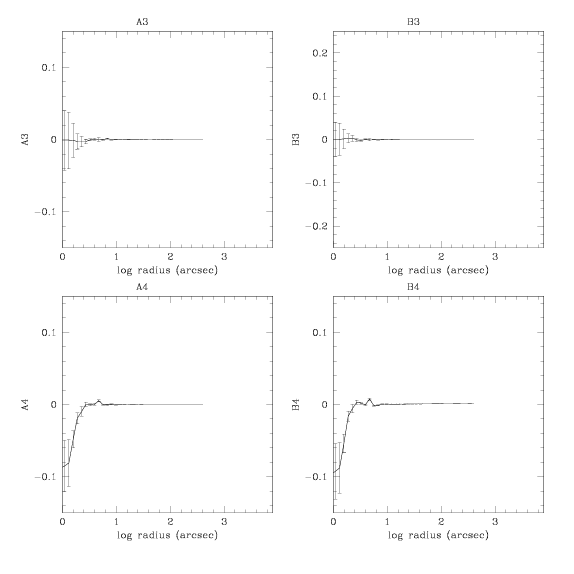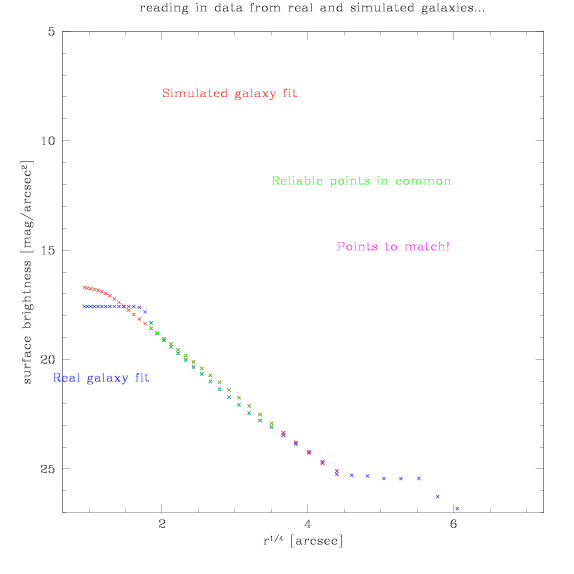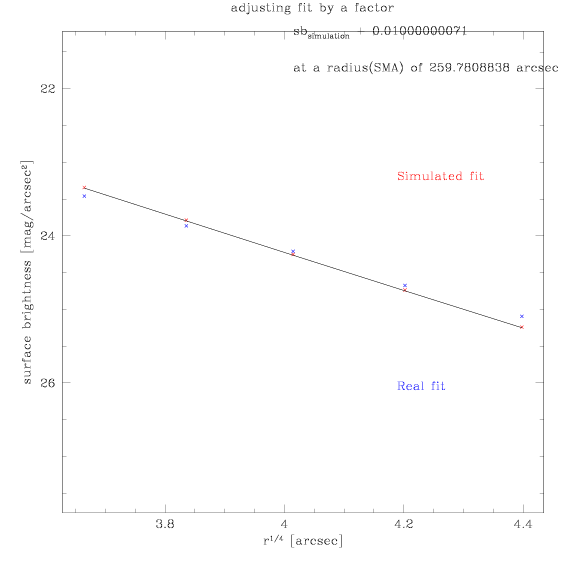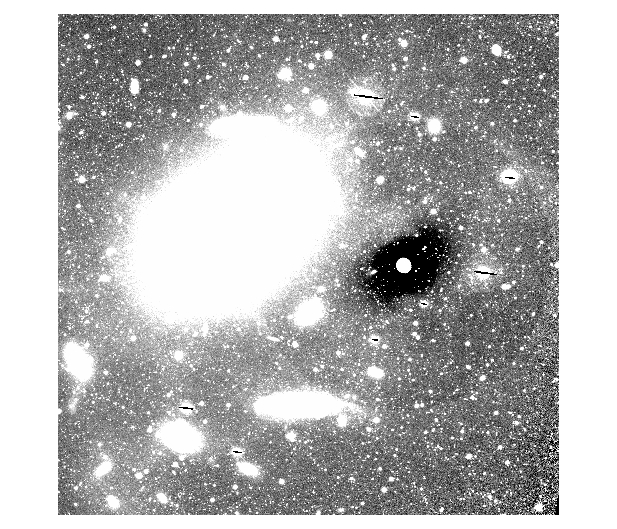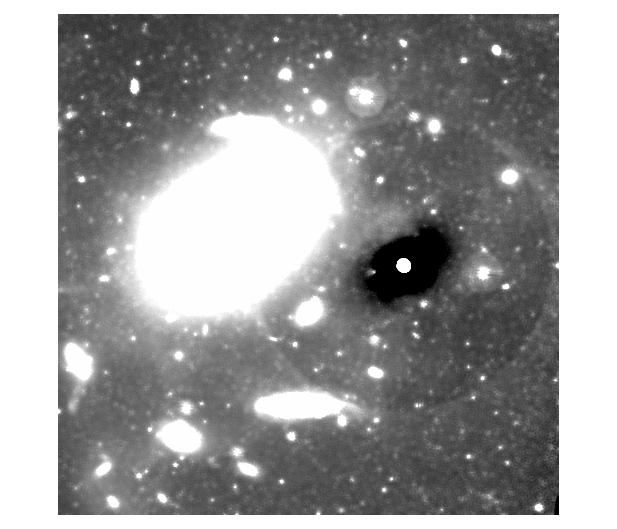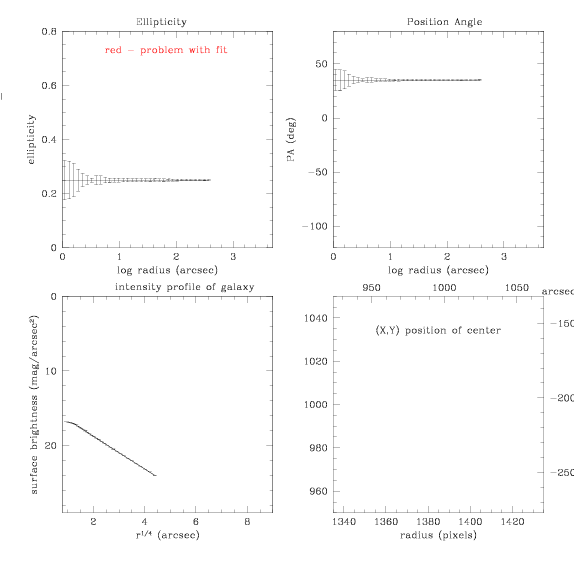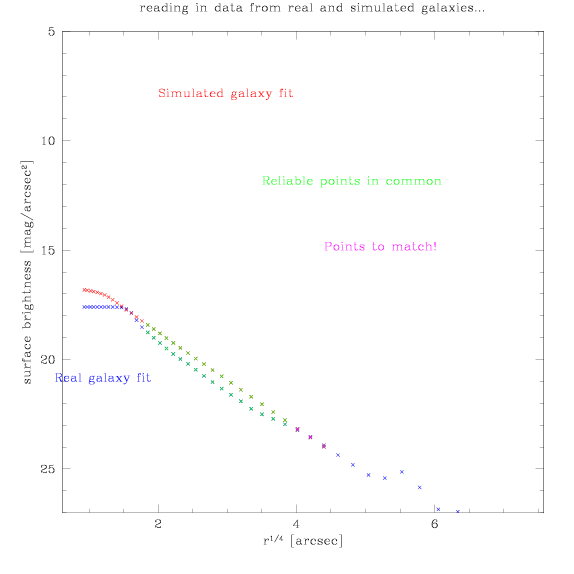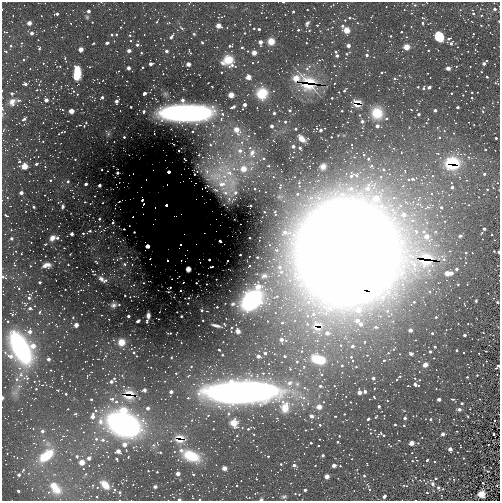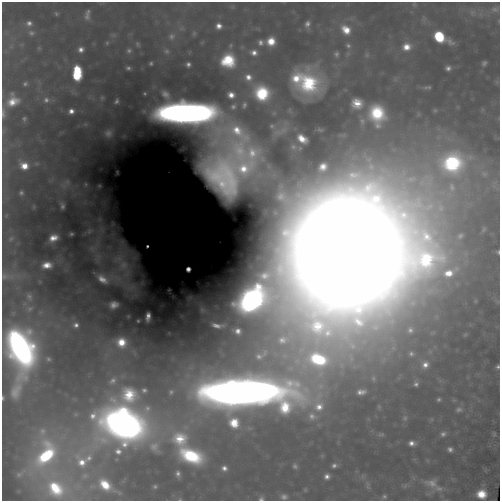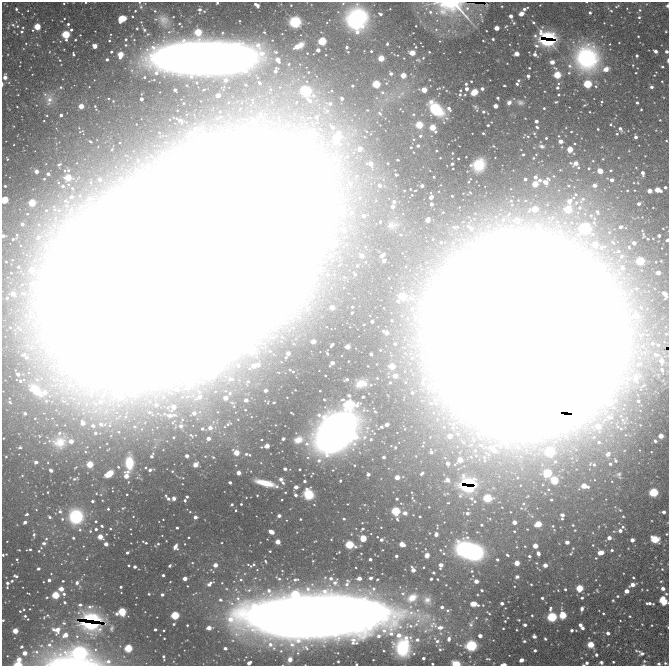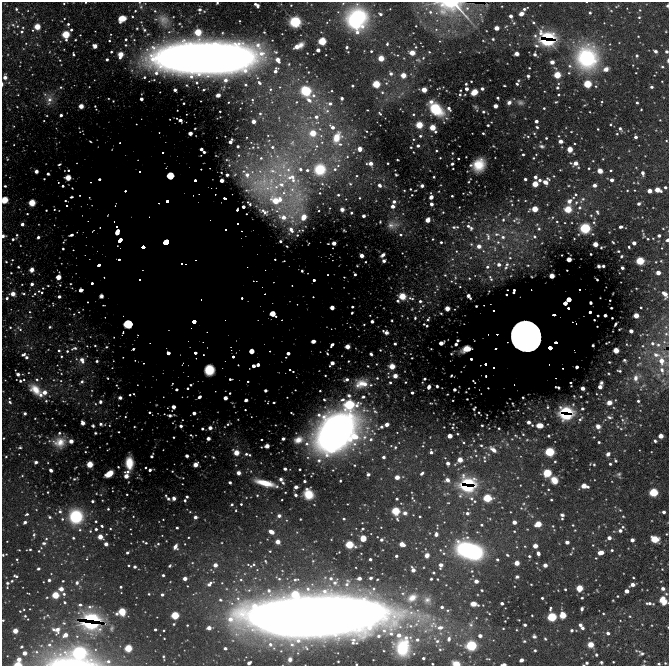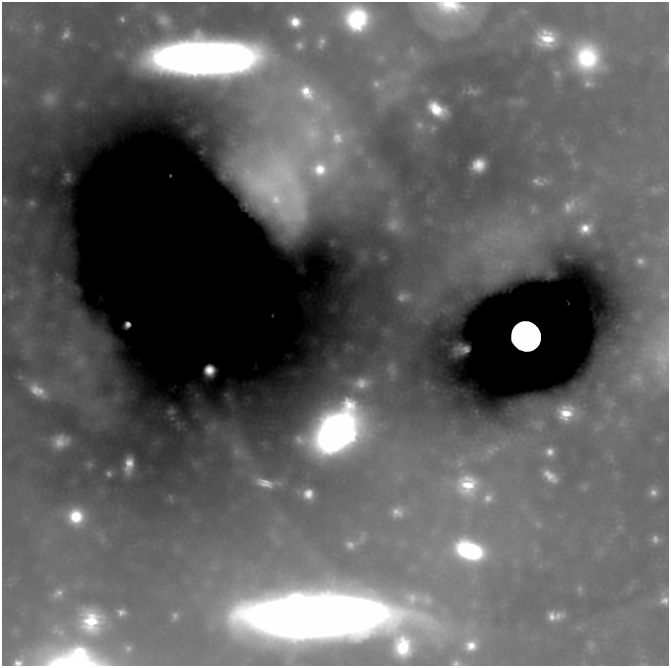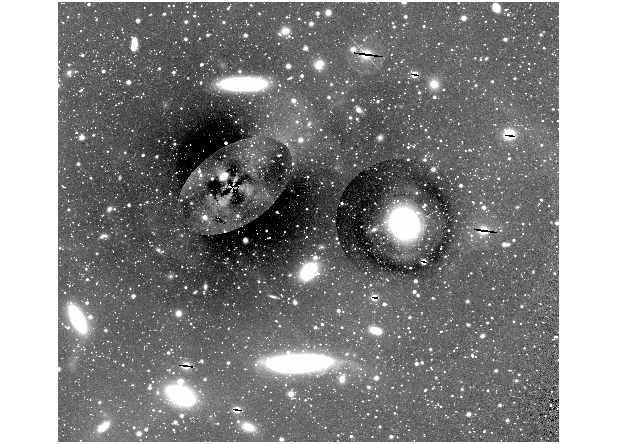
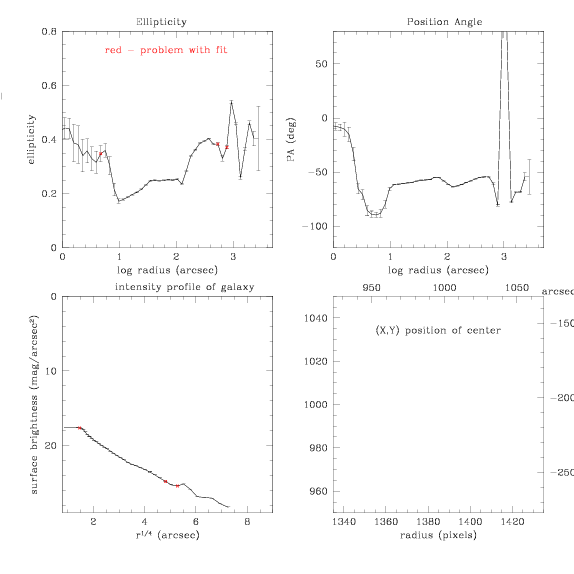
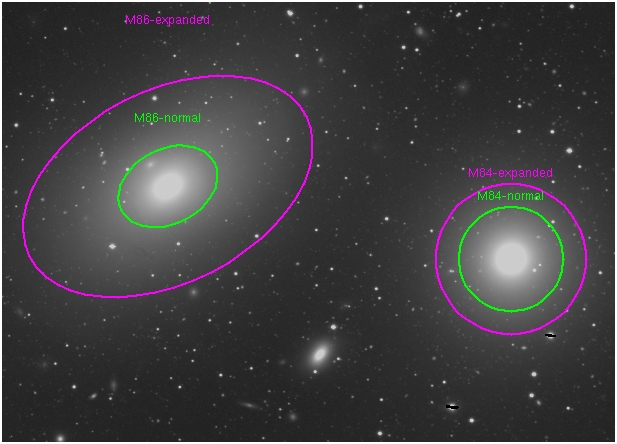
| M84 [Mfind2.dat -
Mfind2.ps.gif] |
M86 [Mfind1.dat -
Mfind1.ps.gif] |
 |
 |
| M84 |
zoom in on
last 5 points |
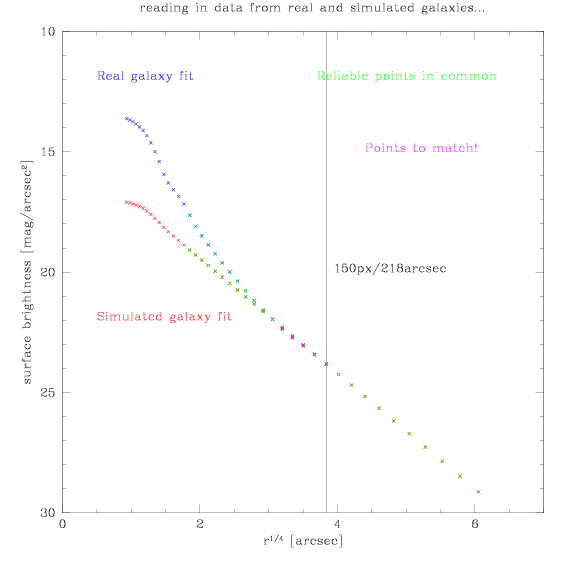 |
 |
| M86 | zoom in on last 5 points |
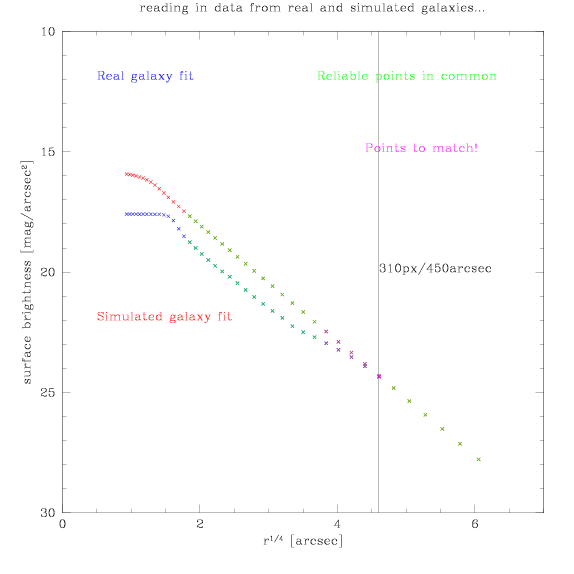 |
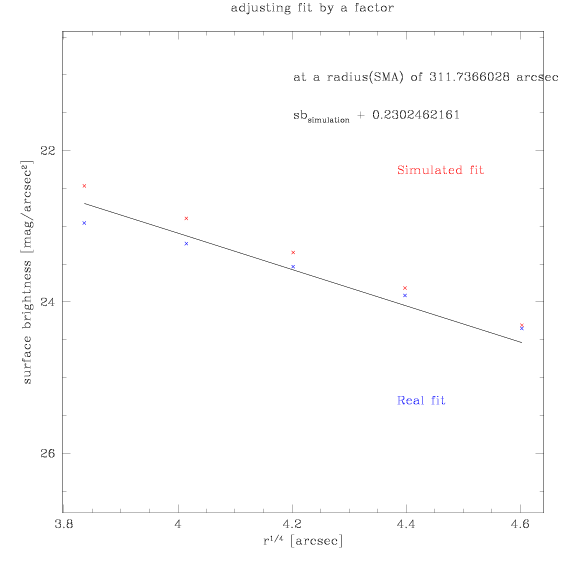 |

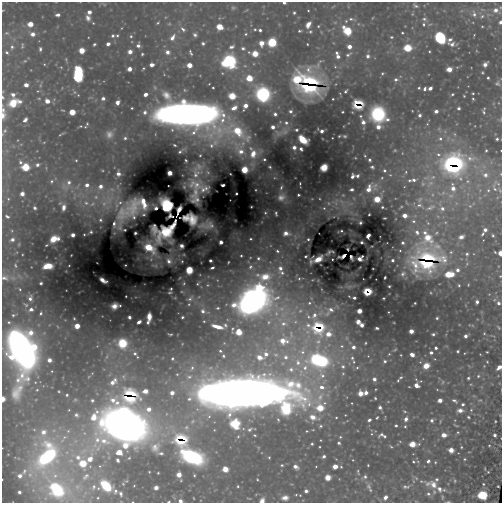
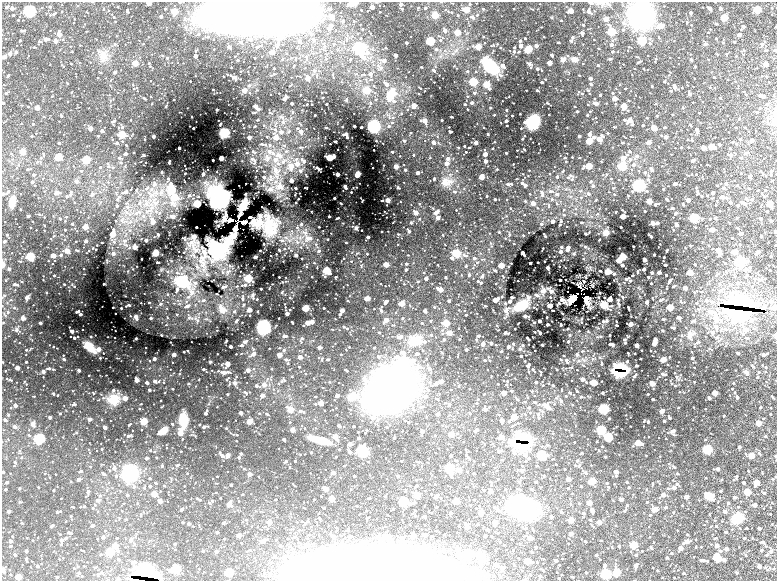
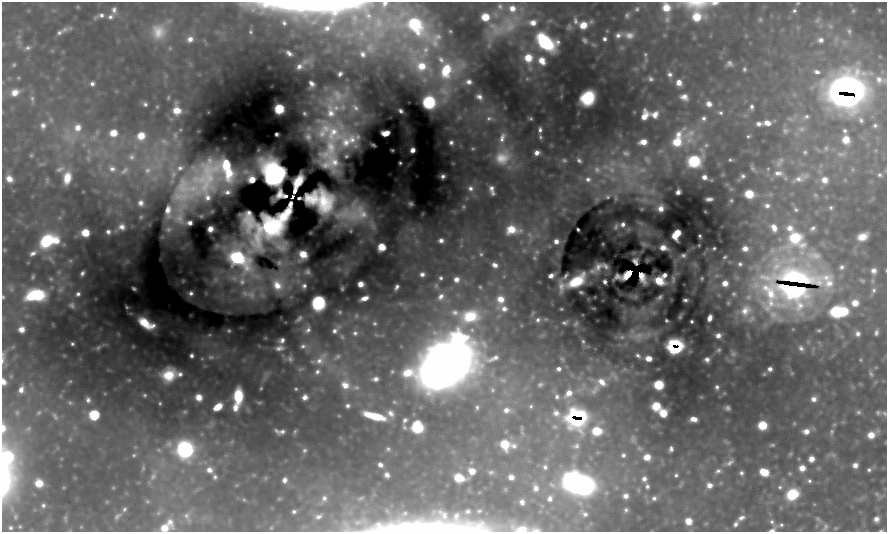
#collection of commands to fit inner regions, extrapolate outer
regions,
# generate combined inner/outer models, and subtract these off
#load packages
stsdas
isophote
noao
artdata
#fit the individual galaxies
#M84:
!rm Mfind2.dat
!rm Mfind2.?.dat
!rm M.pl
!cp Mfind2.pl M.pl
#ellipse input=M.fit output=Mfind2.dat x0=1385 y0=996 ellip0=0.05
pa0=-55 sma0=50 minsma=0 maxsma=104 step=0.2 recente=yes hcenter=no
hellip=no hpa=no
#expanded:
ellipse input=M.fit output=Mfind2.dat x0=1385 y0=996 ellip0=0.05
pa0=-55 sma0=50 minsma=0 maxsma=150 step=0.2 recente=yes hcenter=no
hellip=no hpa=no
#binary-->ascii:
tdump Mfind2.dat cdfile = Mfind2.c.dat pfile = Mfind2.h.dat datafil =
Mfind2.d.dat
#change INDEF --> -9999
#cl < sed2.cl
!sm -m sed.sm Mfind2 quit
#graphe.sm:
!sm -m graphe.sm Mfind2 1 Mfind2.d.dat quit
#model it
imdel Mfind2.fits
#bmodel table=Mfind2.dat output=Mfind2.fits parent=M.fits fulltab=no
minsma=0 maxsma=104
#expanded
bmodel table=Mfind2.dat output=Mfind2.fits parent=M.fits fulltab=no
minsma=0 maxsma=150
#M86:
!rm Mfind1.dat
!rm Mfind1.?.dat
!rm M.pl
!cp Mfind1.pl M.pl
#ellipse input=M.fit output=Mfind1.dat x0=690 y0=1145 ellip0=0.05
pa0=-50 sma0=50 minsma=0 maxsma=104 recente=yes hcenter=no hellip=no
hpa=no
#expanded:
ellipse input=M.fit output=Mfind1.dat x0=690 y0=1145 ellip0=0.05
pa0=-50 sma0=50 minsma=0 maxsma=310 recente=yes hcenter=no hellip=no
hpa=no
#binary-->ascii:
tdump Mfind1.dat cdfile = Mfind1.c.dat pfile = Mfind1.h.dat datafil =
Mfind1.d.dat
#change INDEF --> -9999
!sm -m sed.sm Mfind1 quit
#graphe.sm:
!sm -m graphe.sm Mfind1 1 Mfind1.d.dat quit
#model it
imdel Mfind1.fits
#bmodel table=Mfind1.dat output=Mfind1.fits parent=M.fits fulltab=no
minsma=0 maxsma=104
#expanded:
bmodel table=Mfind1.dat output=Mfind1.fits parent=M.fits fulltab=no
minsma=0 maxsma=310
# re-model with artdata and Corrected Magnitude
#get param file --> egal.dat
#M84:
#!sm -m ee.sm params Mfind2.d.dat egal2.dat 1.35 60 quit
#expanded
!sm -m ee.sm params Mfind2.d.dat egal2.dat 1.45 100 quit
#make the object!
#M84:
imdel model2.fits
mkobject input=model2.fits output=model2.fits ncols=2001 nlines=2001
header=artdata$stdheader.dat backgro=0 objects=egal2.dat xoffset=0
yoffset=0 star=moffat radius=1 beta=2.5 ar=1 pa=0 distanc=1 exptime=1
magzero=1 gain=1 rdnoise=0 poisson=no seed=1
#run ellipse on model#.fits
#M84:
!rm model2.dat
#ellipse input=model2.fits output=model2.dat x0=1385 y0=996 ellip0=0.05
pa0=-25 sma0=50 minsma=0 maxsma=1000 recente=no hcenter=yes hellip=yes
hpa=yes
#expanded
ellipse input=model2.fits output=model2.dat x0=1385 y0=996 ellip0=0.05
pa0=13.0 sma0=50 minsma=0 maxsma=1000 recente=no hcenter=yes hellip=yes
hpa=yes
#binary-->ascii:
#M84:
!rm model2.?.dat
tdump model2.dat cdfile = model2.c.dat pfile = model2.h.dat datafil =
model2.d.dat
!sm -m sed.sm model2 quit
#graphe.sm:
#M84:
!rm model2.ps
!rm model2.ps.gif
!sm -m graphe.sm model2 1 model2.d.dat quit
#check offset/seam:
# program: realdata modeldata outputpicture num2match version/type
#!sm -m fitfit.sm Mfind2.d.dat model2.d.dat M84realmod 4 0 quit
#expanded
!sm -m fitfit.sm Mfind2.d.dat model2.d.dat M84realmod 4 2 quit
#M86:
#set up running parameters for artdata:
# realdata outputfile magoffset
(halfflux)radius
#!sm -m ee.sm params Mfind1.d.dat egal1.dat 1.65 100 quit
#expanded:
!sm -m ee.sm params Mfind1.d.dat egal1.dat 0.55 100 quit
imdel model1.fits
mkobject input=model1.fits output=model1.fits ncols=2001 nlines=2001
header=artdata$stdheader.dat backgro=0 objects=egal1.dat xoffset=0
yoffset=0 star=moffat radius=1 beta=2.5 ar=1 pa=0 distanc=1 exptime=1
magzero=1 gain=1 rdnoise=0 poisson=no seed=1
#M86:
!rm model1.dat
#ellipse input=model1.fits output=model1.dat x0=698 y0=1141
ellip0=0.283 pa0=-62.9 sma0=50 minsma=0 maxsma=1000 recente=no
hcenter=yes hellip=yes hpa=yes
#expanded:
ellipse input=model1.fits output=model1.dat x0=698 y0=1141 ellip0=0.382
pa0=-53.8 sma0=50 minsma=0 maxsma=1000 recente=no hcenter=yes
hellip=yes hpa=yes
#M86:
!rm model1.?.dat
tdump model1.dat cdfile = model1.c.dat pfile = model1.h.dat datafil =
model1.d.dat
!sm -m sed.sm model1 quit
#M86:
!rm model1.ps
!rm model1.ps.gif
!sm -m graphe.sm model1 1 model1.d.dat quit
#check offset/seam:
# program: realdata modeldata outputpicture num2match version/type
#!sm -m fitfit.sm Mfind1.d.dat model1.d.dat M86realmod 4 0 quit
#expanded
!sm -m fitfit.sm Mfind1.d.dat model1.d.dat M86realmod 4 1 quit
#CENTERS
#use ellipse fits to generate (with bmodel using ellipse tables)
central models
#M84:
imdel inner2.fits
#bmodel table=Mfind2.dat output=inner2.fits parent=M.fits fulltab=no
minsma=0 maxsma=104
imcopy Mfind2.fits inner2.fits
#M86:
imdel inner1.fits
#bmodel table=Mfind1.dat output=inner1.fits parent=M.fits fulltab=no
minsma=0 maxsma=104
imcopy Mfind1.fits inner1.fits
#combine central regions with big picture (from bmodel)
#M84:
imdel combine2.fits
imexpr expr='(a>0)?a:b' output=combine2.fits a=inner2.fits
b=model2.fits
imdel temp2.fits
imarith M.fits - combine2.fits temp2.fits
#M86:
imdel combine1.fits
imexpr expr='(a>0)?a:b' output=combine1.fits a=inner1.fits
b=model1.fits
imdel temp1.fits
imarith M.fits - combine1.fits temp1.fits
#combined:
imdel combine.fits
imarith combine1.fits + combine2.fits combine.fits
#perform final subtraction
imdel Msubtract.fits
imarith M.fits - combine.fits Msubtract.fits

